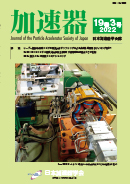Volume 19, Issue 3
Displaying 1-11 of 11 articles from this issue
- |<
- <
- 1
- >
- >|
Preace
-
2022Volume 19Issue 3 Pages 123
Published: October 31, 2022
Released on J-STAGE: October 31, 2022
Download PDF (455K)
Topics
-
2022Volume 19Issue 3 Pages 124-130
Published: October 31, 2022
Released on J-STAGE: October 31, 2022
Download PDF (1108K) -
2022Volume 19Issue 3 Pages 131-139
Published: October 31, 2022
Released on J-STAGE: October 31, 2022
Download PDF (17258K) -
2022Volume 19Issue 3 Pages 140-149
Published: October 31, 2022
Released on J-STAGE: October 31, 2022
Download PDF (2465K)
Meeting Reports
-
2022Volume 19Issue 3 Pages 150-156
Published: October 31, 2022
Released on J-STAGE: October 31, 2022
Download PDF (2217K) -
2022Volume 19Issue 3 Pages 157-158
Published: October 31, 2022
Released on J-STAGE: October 31, 2022
Download PDF (257K)
Supporting Members
-
2022Volume 19Issue 3 Pages 159-162
Published: October 31, 2022
Released on J-STAGE: October 31, 2022
Download PDF (2685K)
Notice Board & PASJ Announcements
-
2022Volume 19Issue 3 Pages 163
Published: October 31, 2022
Released on J-STAGE: November 06, 2024
Download PDF (225K) -
2022Volume 19Issue 3 Pages 164
Published: October 31, 2022
Released on J-STAGE: November 06, 2024
Download PDF (204K)
-
2022Volume 19Issue 3 Pages 165-166
Published: October 31, 2022
Released on J-STAGE: November 06, 2024
Download PDF (240K)
List of Supporting Members
-
2022Volume 19Issue 3 Pages 167
Published: October 31, 2022
Released on J-STAGE: November 06, 2024
Download PDF (181K)
- |<
- <
- 1
- >
- >|
